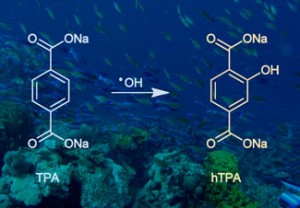A sensitive probe to monitor hydroxyl radicals in water has been developed by a team of Swiss and US scientists.
Hydroxyl radicals are high-energy oxidants that are important in the biology of ageing and radiation damage, as well as in environmental chemistry. In natural water systems, the radicals are produced photochemically from nutrients such as nitrates or nitrites and pollutants such as dissolved organic matter. And accurately measuring hydroxyl radical concentrations can help understand the fate of pollutants.
fate of pollutants.
Current hydroxyl radical probes, such as benzoic acid, often have limited sensitivity, require long irradiation times or high concentrations of the probe, which can affect the sample. Now Kristopher McNeill at the Swiss Federal Institute of Technology (ETH) in Zurich and colleagues at the University of Minnesota in Minneapolis have discovered that terephthalate is a more sensitive probe for hydroxyl radicals in aquatic environments.
Terephthalate picks up an OH radical to form fluorescent hydroxyterephthalate
Click here to read the full story
Link to journal article:
Terephthalate as a probe for photochemically generated hydroxyl radical
Sarah E. Page, William A. Arnold and Kristopher McNeill, J. Environ. Monit., 2010, 12, 1658
DOI: 10.1039/c0em00160k










